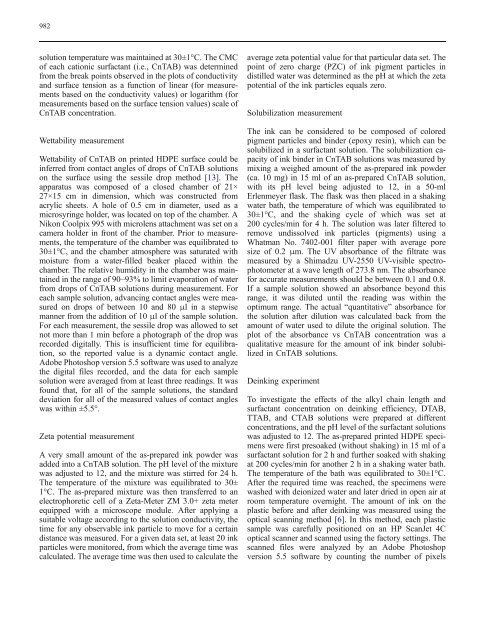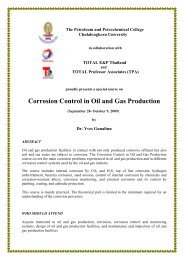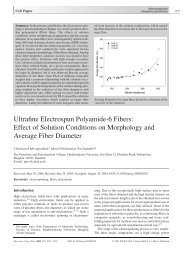Removal of solvent-based ink from printed surface of HDPE bottles ...
Removal of solvent-based ink from printed surface of HDPE bottles ...
Removal of solvent-based ink from printed surface of HDPE bottles ...
You also want an ePaper? Increase the reach of your titles
YUMPU automatically turns print PDFs into web optimized ePapers that Google loves.
982<br />
solution temperature was maintained at 30±1°C. The CMC<br />
<strong>of</strong> each cationic surfactant (i.e., CnTAB) was determined<br />
<strong>from</strong> the break points observed in the plots <strong>of</strong> conductivity<br />
and <strong>surface</strong> tension as a function <strong>of</strong> linear (for measurements<br />
<strong>based</strong> on the conductivity values) or logarithm (for<br />
measurements <strong>based</strong> on the <strong>surface</strong> tension values) scale <strong>of</strong><br />
CnTAB concentration.<br />
Wettability measurement<br />
Wettability <strong>of</strong> CnTAB on <strong>printed</strong> <strong>HDPE</strong> <strong>surface</strong> could be<br />
inferred <strong>from</strong> contact angles <strong>of</strong> drops <strong>of</strong> CnTAB solutions<br />
on the <strong>surface</strong> using the sessile drop method [13]. The<br />
apparatus was composed <strong>of</strong> a closed chamber <strong>of</strong> 21×<br />
27×15 cm in dimension, which was constructed <strong>from</strong><br />
acrylic sheets. A hole <strong>of</strong> 0.5 cm in diameter, used as a<br />
microsyringe holder, was located on top <strong>of</strong> the chamber. A<br />
Nikon Coolpix 995 with microlens attachment was set on a<br />
camera holder in front <strong>of</strong> the chamber. Prior to measurements,<br />
the temperature <strong>of</strong> the chamber was equilibrated to<br />
30±1°C, and the chamber atmosphere was saturated with<br />
moisture <strong>from</strong> a water-filled beaker placed within the<br />
chamber. The relative humidity in the chamber was maintained<br />
in the range <strong>of</strong> 90–93% to limit evaporation <strong>of</strong> water<br />
<strong>from</strong> drops <strong>of</strong> CnTAB solutions during measurement. For<br />
each sample solution, advancing contact angles were measured<br />
on drops <strong>of</strong> between 10 and 80 μl in a stepwise<br />
manner <strong>from</strong> the addition <strong>of</strong> 10 μl <strong>of</strong> the sample solution.<br />
For each measurement, the sessile drop was allowed to set<br />
not more than 1 min before a photograph <strong>of</strong> the drop was<br />
recorded digitally. This is insufficient time for equilibration,<br />
so the reported value is a dynamic contact angle.<br />
Adobe Photoshop version 5.5 s<strong>of</strong>tware was used to analyze<br />
the digital files recorded, and the data for each sample<br />
solution were averaged <strong>from</strong> at least three readings. It was<br />
found that, for all <strong>of</strong> the sample solutions, the standard<br />
deviation for all <strong>of</strong> the measured values <strong>of</strong> contact angles<br />
was within ±5.5°.<br />
Zeta potential measurement<br />
A very small amount <strong>of</strong> the as-prepared <strong>ink</strong> powder was<br />
added into a CnTAB solution. The pH level <strong>of</strong> the mixture<br />
was adjusted to 12, and the mixture was stirred for 24 h.<br />
The temperature <strong>of</strong> the mixture was equilibrated to 30±<br />
1°C. The as-prepared mixture was then transferred to an<br />
electrophoretic cell <strong>of</strong> a Zeta-Meter ZM 3.0+ zeta meter<br />
equipped with a microscope module. After applying a<br />
suitable voltage according to the solution conductivity, the<br />
time for any observable <strong>ink</strong> particle to move for a certain<br />
distance was measured. For a given data set, at least 20 <strong>ink</strong><br />
particles were monitored, <strong>from</strong> which the average time was<br />
calculated. The average time was then used to calculate the<br />
average zeta potential value for that particular data set. The<br />
point <strong>of</strong> zero charge (PZC) <strong>of</strong> <strong>ink</strong> pigment particles in<br />
distilled water was determined as the pH at which the zeta<br />
potential <strong>of</strong> the <strong>ink</strong> particles equals zero.<br />
Solubilization measurement<br />
The <strong>ink</strong> can be considered to be composed <strong>of</strong> colored<br />
pigment particles and binder (epoxy resin), which can be<br />
solubilized in a surfactant solution. The solubilization capacity<br />
<strong>of</strong> <strong>ink</strong> binder in CnTAB solutions was measured by<br />
mixing a weighed amount <strong>of</strong> the as-prepared <strong>ink</strong> powder<br />
(ca. 10 mg) in 15 ml <strong>of</strong> an as-prepared CnTAB solution,<br />
with its pH level being adjusted to 12, in a 50-ml<br />
Erlenmeyer flask. The flask was then placed in a shaking<br />
water bath, the temperature <strong>of</strong> which was equilibrated to<br />
30±1°C, and the shaking cycle <strong>of</strong> which was set at<br />
200 cycles/min for 4 h. The solution was later filtered to<br />
remove undissolved <strong>ink</strong> particles (pigments) using a<br />
Whatman No. 7402-001 filter paper with average pore<br />
size <strong>of</strong> 0.2 μm. The UV absorbance <strong>of</strong> the filtrate was<br />
measured by a Shimadzu UV-2550 UV-visible spectrophotometer<br />
at a wave length <strong>of</strong> 273.8 nm. The absorbance<br />
for accurate measurements should be between 0.1 and 0.8.<br />
If a sample solution showed an absorbance beyond this<br />
range, it was diluted until the reading was within the<br />
optimum range. The actual “quantitative” absorbance for<br />
the solution after dilution was calculated back <strong>from</strong> the<br />
amount <strong>of</strong> water used to dilute the original solution. The<br />
plot <strong>of</strong> the absorbance vs CnTAB concentration was a<br />
qualitative measure for the amount <strong>of</strong> <strong>ink</strong> binder solubilized<br />
in CnTAB solutions.<br />
De<strong>ink</strong>ing experiment<br />
To investigate the effects <strong>of</strong> the alkyl chain length and<br />
surfactant concentration on de<strong>ink</strong>ing efficiency, DTAB,<br />
TTAB, and CTAB solutions were prepared at different<br />
concentrations, and the pH level <strong>of</strong> the surfactant solutions<br />
was adjusted to 12. The as-prepared <strong>printed</strong> <strong>HDPE</strong> specimens<br />
were first presoaked (without shaking) in 15 ml <strong>of</strong> a<br />
surfactant solution for 2 h and further soaked with shaking<br />
at 200 cycles/min for another 2 h in a shaking water bath.<br />
The temperature <strong>of</strong> the bath was equilibrated to 30±1°C.<br />
After the required time was reached, the specimens were<br />
washed with deionized water and later dried in open air at<br />
room temperature overnight. The amount <strong>of</strong> <strong>ink</strong> on the<br />
plastic before and after de<strong>ink</strong>ing was measured using the<br />
optical scanning method [6]. In this method, each plastic<br />
sample was carefully positioned on an HP ScanJet 4C<br />
optical scanner and scanned using the factory settings. The<br />
scanned files were analyzed by an Adobe Photoshop<br />
version 5.5 s<strong>of</strong>tware by counting the number <strong>of</strong> pixels





